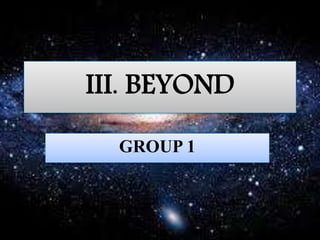
Beyond
- 2. TOPICS • The Universe • Solar System • The Earth • Oceans of the World • Geographical Comparison • The Plates • The globes and the maps • Map Projection
- 3. GROUP 1: Members • Kathrina Trañas • Darlyn Therese Yap • Carissa Jaica Montes • Maria Kristina Ramos • Janine Japone • Kem Danica Rivera • Rona Medes • Fatima Contreras • Eunice Claire Villaruel • Gemma Butardo • Rhodora Morales • Akmilla Sangkaan
- 4. THE UNIVERSE Kathrina T. Trañas BEED III-C
- 5. The Universe -defined as the totality of existence -includes the planets, stars, galaxies, the contents of intergalactic space, and all matter and energy. -similar terms include the cosmos, the world and nature.
- 6. AGE • 13.7 billion years old, give or take 130 million years. In comparison, the solar system is only about 4.6 billion years old. • This estimate came from measuring the composition of matter and energy density in the universe. The Universe
- 7. CONTENT • Until about 30 years ago, astronomers thought that the universe was composed almost entirely of ordinary atoms, or "baryonic matter." The Universe
- 8. SHAPE • whether or not it is finite or infinite in extent depends on the struggle between the rate of its expansion and the pull of gravity. The Universe
- 9. PLANETS • The eight planets that orbit the sun are (in order from the sun): Mercury, Venus, Earth, Mars, Ju piter, Saturn, Uranus, Neptune. • Another large body is Pluto, now classified as a dwarf planet or plutoid. The Universe
- 11. • "My Very Excellent Mother Just Sent Us Nine Pizzas" and "My Very Easy Method Just Simplifies Us Naming Planets" The Universe PLANETS
- 12. • The largest planet is Jupiter. It is followed by Saturn, Uranus, Neptune, Earth, Venus, Mars, Mercury, and finally, tiny Pluto (the largest of the dwarf planets). Jupiter is so big that all the other planets could fit inside it. The Universe PLANETS
- 13. The Inner Planets vs. the Outer Planets • The inner planets (those planets that orbit close to the sun) are quite different from the outer planets (those planets that orbit far from the sun). The Universe
- 14. The Universe The Inner Planets vs. the Outer Planets • The inner planets are: Mercury, Venus, Earth, and Mars. They are relatively small, composed mostly of rock, and have few or no moons.
- 15. • The outer planets include: Jupiter, Saturn, Uranus, Neptune, and Pluto (a dwarf planet). They are mostly huge, mostly gaseous, ringed, and have many moons (again, the exception is Pluto, the dwarf planet, which is small, rocky, and has four moons). The Universe The Inner Planets vs. the Outer Planets
- 16. Temperatures on the Planets • Generally, the farther from the Sun, the cooler the planet. Differences occur when the greenhouse effect warms a planet (like Venus) surrounded by a thick atmosphere. The Universe
- 18. STARS • Sun is the nearest star to Earth. The Universe
- 19. STARS AGE • Most stars are between 1 billion and 10 billion years old. • Some stars may even be close to 13.8 billion years old—the observed age of the universe. The oldest star yet discovered, HE 1523-0901, is an estimated 13.2 billion years old. The Universe
- 20. • The more massive the star, the shorter its lifespan, primarily because massive stars have greater pressure on their cores, causing them to burn hydrogen more rapidly. STARS The Universe
- 21. • The most massive stars last an average of a few million years, while stars of minimum mass (red dwarfs) burn their fuel very slowly and last tens to hundreds of billions of years. STARS The Universe
- 22. MASS • Eta Carinae - One of the most massive stars. - with 100–150 times as much mass as the Sun, will have a lifespan of only several million years. STARS The Universe
- 23. • A study of the Arches cluster suggests that 150 solar masses is the upper limit for stars in the current era of the universe. • The reason for this limit is not precisely known, but it is partially due to the Eddington luminosity which defines the maximum amount of luminosity that can pass through the atmosphere of a star without ejecting the gases into space. STARS The Universe
- 24. • a star named R136a1 in the Large Magellanic Cloud, RMC 136a star cluster has been measured at 265 solar masses, which puts this limit into question. STARS The Universe
- 25. • A study determined that stars larger than 150 solar masses in R136 were created through the collision and merger of massive stars in close binary systems, providing a way to sidestep the 150 solar mass limit. STARS The Universe
